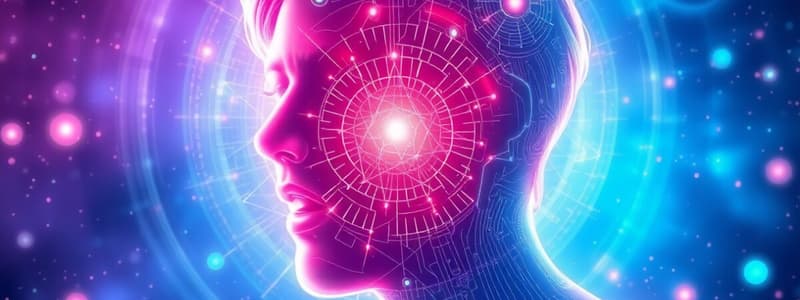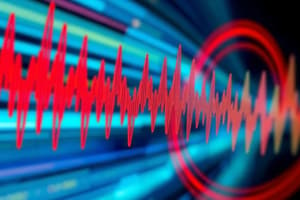Podcast
Questions and Answers
What is the primary function of an automatic speech recognition (ASR) system?
What is the primary function of an automatic speech recognition (ASR) system?
- To analyze speech patterns for language learning
- To convert written text into audio files
- To record human speech for preservation
- To convert audio speech into text (correct)
What obstacle is considered one of the biggest challenges in creating an autonomous speech recognition system?
What obstacle is considered one of the biggest challenges in creating an autonomous speech recognition system?
- Creating a fast processing algorithm
- Standardizing voice commands across languages
- Variations in human speech and accents (correct)
- Implementing a universal grammar structure
Which type of individuals tend to exhibit more variations in their speech patterns according to the content?
Which type of individuals tend to exhibit more variations in their speech patterns according to the content?
- Bilingual or multilingual speakers (correct)
- Children learning language
- Elderly speakers
- Native speakers of a single language
What does an ideal ASR need to do with the recognized words?
What does an ideal ASR need to do with the recognized words?
How can the input for an ASR be received?
How can the input for an ASR be received?
What factor can create challenges in an ASR's accuracy?
What factor can create challenges in an ASR's accuracy?
Which illustrates the relationship between the input and output sequences in an ASR?
Which illustrates the relationship between the input and output sequences in an ASR?
What is the intended purpose of creating an ASR?
What is the intended purpose of creating an ASR?
What is the main goal of preprocessing in an automatic speech recognition (ASR) system?
What is the main goal of preprocessing in an automatic speech recognition (ASR) system?
Which module of the ASR system is responsible for extracting coefficients from speech signals?
Which module of the ASR system is responsible for extracting coefficients from speech signals?
What are Melfrequency cepstral coefficients (MFCCs) primarily used for in an ASR system?
What are Melfrequency cepstral coefficients (MFCCs) primarily used for in an ASR system?
Which factor does NOT impact the performance of the classification module in an ASR system?
Which factor does NOT impact the performance of the classification module in an ASR system?
Which of the following is NOT mentioned as a preprocessing method for reducing noise in audio signals?
Which of the following is NOT mentioned as a preprocessing method for reducing noise in audio signals?
What does P(Y|X) represent in the context of ASR?
What does P(Y|X) represent in the context of ASR?
Which component of an ASR system processes the clean speech signal after preprocessing?
Which component of an ASR system processes the clean speech signal after preprocessing?
What is a common challenge for feature extraction methods in ASR?
What is a common challenge for feature extraction methods in ASR?
What is one of the main reasons speech was not utilized in human-machine communication in the past?
What is one of the main reasons speech was not utilized in human-machine communication in the past?
Which component is responsible for converting speech into text in spoken language systems?
Which component is responsible for converting speech into text in spoken language systems?
What is NOT a purpose of speech processing?
What is NOT a purpose of speech processing?
Which of the following is NOT one of the four major components of spoken language systems?
Which of the following is NOT one of the four major components of spoken language systems?
What challenge related to Automatic Speech Recognition (ASR) arises from the presence of background noise?
What challenge related to Automatic Speech Recognition (ASR) arises from the presence of background noise?
In spoken language systems, what role does the dialog manager serve?
In spoken language systems, what role does the dialog manager serve?
Which factor is NOT a source of variation affecting ASR from a linguistic perspective?
Which factor is NOT a source of variation affecting ASR from a linguistic perspective?
What aspect of speech processing focuses on improving the intelligibility and quality of the speech signal?
What aspect of speech processing focuses on improving the intelligibility and quality of the speech signal?
Flashcards
Automatic Speech Recognition (ASR)
Automatic Speech Recognition (ASR)
A system that converts spoken audio into text.
ASR Input
ASR Input
Audio file or microphone input used by the ASR system.
ASR Output
ASR Output
The text representation of the spoken input provided by the ASR.
Speech Variations
Speech Variations
Signup and view all the flashcards
ASR Classification
ASR Classification
Signup and view all the flashcards
Input Sequence (X)
Input Sequence (X)
Signup and view all the flashcards
Output Sequence (Y)
Output Sequence (Y)
Signup and view all the flashcards
ASR Goal
ASR Goal
Signup and view all the flashcards
ASR Architecture
ASR Architecture
Signup and view all the flashcards
Preprocessing Module
Preprocessing Module
Signup and view all the flashcards
Feature Extraction
Feature Extraction
Signup and view all the flashcards
Classification Model
Classification Model
Signup and view all the flashcards
Language Model
Language Model
Signup and view all the flashcards
MFCCs (Mel-Frequency Cepstral Coefficients)
MFCCs (Mel-Frequency Cepstral Coefficients)
Signup and view all the flashcards
Signal-to-Noise Ratio (SNR)
Signal-to-Noise Ratio (SNR)
Signup and view all the flashcards
Automatic Speech Recognition (ASR)
Automatic Speech Recognition (ASR)
Signup and view all the flashcards
Automatic Speech Recognition (ASR)
Automatic Speech Recognition (ASR)
Signup and view all the flashcards
Speech Recognition Component
Speech Recognition Component
Signup and view all the flashcards
Spoken Language Understanding
Spoken Language Understanding
Signup and view all the flashcards
Text-to-Speech
Text-to-Speech
Signup and view all the flashcards
Dialog Manager
Dialog Manager
Signup and view all the flashcards
Speaker Variability
Speaker Variability
Signup and view all the flashcards
Environmental Noise
Environmental Noise
Signup and view all the flashcards
ASR Challenge (Style)
ASR Challenge (Style)
Signup and view all the flashcards
Study Notes
Automatic Speech Recognition (ASR)
- Speech is the most natural, efficient, and preferred mode of communication between humans.
- People are more comfortable using speech as input for machines than keypads or keyboards.
- ASR converts audio (microphone or file) into text.
- An ideal ASR "perceives" input, "recognizes" spoken words, and uses them as input for another machine.
- ASR is seen as the future of communication between humans and machines.
Challenges of ASR
- Human speech and accents have huge variations.
- This variation in speech patterns is a significant obstacle for autonomous speech recognition systems.
- Bilingual or multilingual people display more variations in their speech patterns compared to monolingual speakers.
- Each speaker possesses a unique voice and speaking style.
- ASR systems can be designed categorized by speaker independence (e.g., speaker-independent, speaker-dependent, and speaker-adaptive), vocabulary size (e.g., small, medium, large, very large), speaking style (e.g., isolated words, connected words, continuous speech, spontaneous speech), and channel variability.
ASR Architecture
-
ASR takes a sound wave input and converts it into text.
-
Data can be from sound waves (via microphone) or audio file.
-
ASR input sequence is denoted by X (with n representing the length).
-
ASR calculates an output sequence Y given the highest posterior probability P(Y|X).
-
The output sequence Y has the highest posterior probability given X.
-
ASR has 4 modules:
- Pre-processing (cleans the sound wave)
- Feature Extraction (extracts relevant speech features)
- Classification (attempts to assign the extracted features to words)
- Language Model (uses existing knowledge of word order)
-
Noise (and other interference) may be present alongside recorded audio, so it needs to be reduced.
Feature Extraction
- Preprocessing methods (e.g., filters, framing, normalization, pre-emphasis) can be utilized to reduce noise.
- Preprocessing choices depend on the algorithm selected for feature extraction.
- Commonly used methods include Mel-frequency cepstral coefficients (MFCCs), linear predictive coding (LPC), and discrete wavelet transform (DWT).
Components in Spoken Language Systems
- Spoken language systems can include one or more of four components:
- Speech Recognition (converts speech to text)
- Spoken Language Understanding (identifies the meaning of words)
- Text-to-Speech (converts text to speech)
- Dialog Manager (communicates with other components and applications).
- ASR is one of the four key components of spoken language systems.
- These components are all crucial for successful spoken language systems
Additional Considerations
- ASR has been a research area for five decades, seen as an important bridge for improving human-human and human-machine communication.
- In the past, speech has not been a widely used modality for human-computer interaction due to technology limitations and the dominance of keyboard/mouse interaction.
- A typical speech-to-speech translation system has three components (Speech Recognition, Machine Translation, Text-to-Speech).
Studying That Suits You
Use AI to generate personalized quizzes and flashcards to suit your learning preferences.




